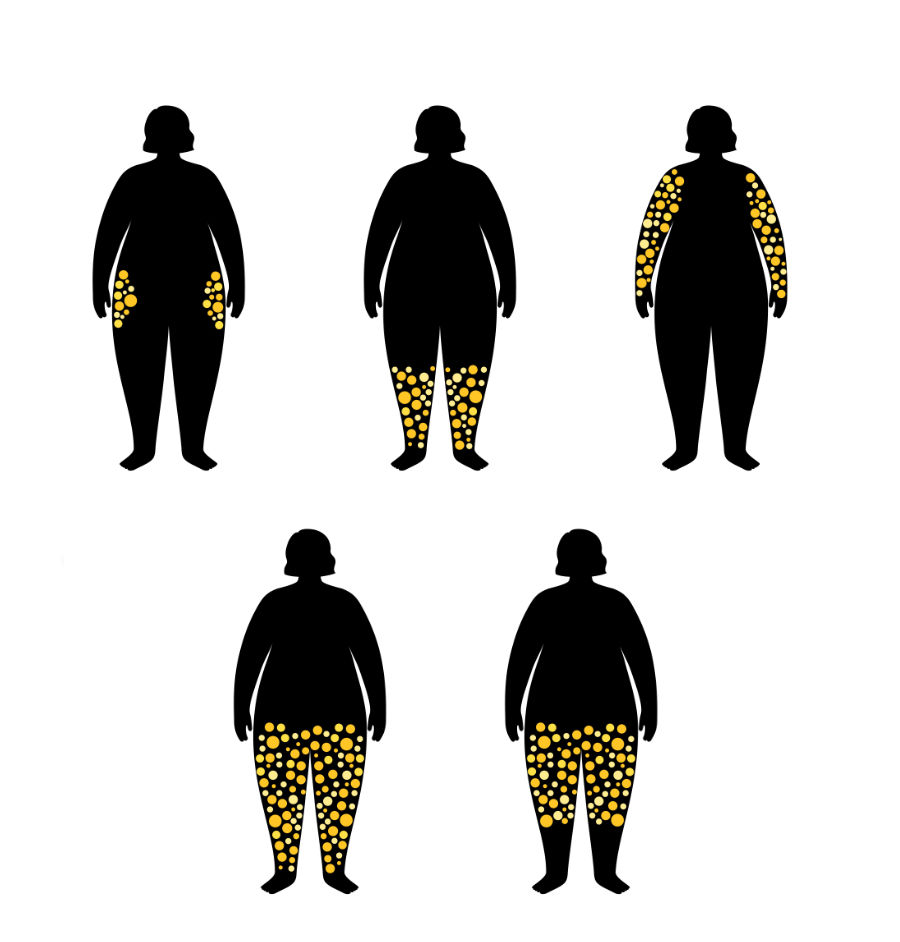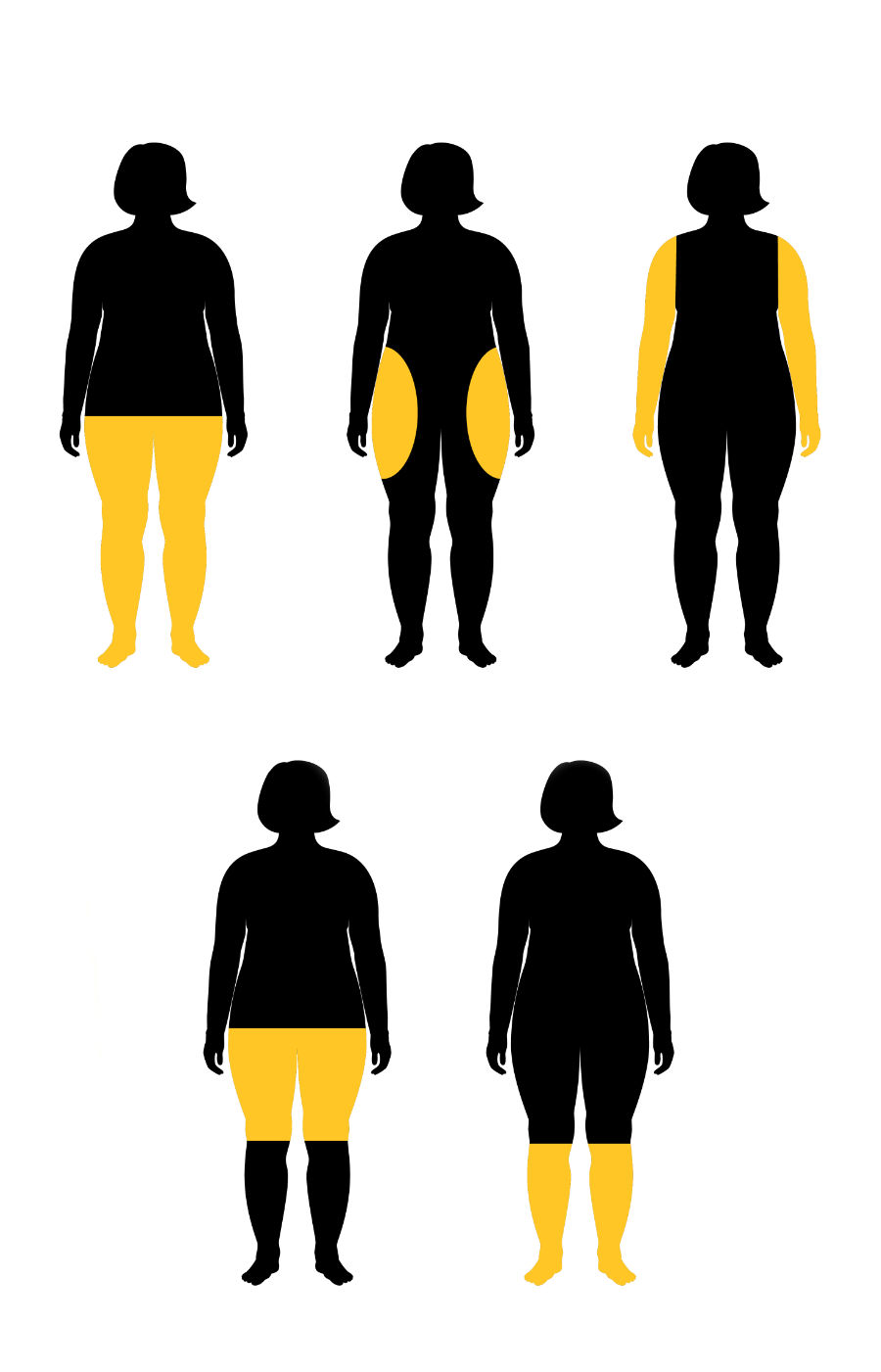What is Lipedema?
Even though more than 1 in 10 women around the world are affected by Lipedema, it’s still a relatively unknown health condition. What exactly is it? We all have fat cells (also known as adipose tissue), which help our body with insulation and cushioning. Lipedema affects the way that these fat cells accumulate in the body, resulting in irregular, bulging fat. This excessive clustering of fat cells is unfortunately resistant to both diet and exercise.
Lipedema is not the same thing as Lymphedema or general obesity. Lipedema most commonly affects the legs, though sometimes it also affects the torso or arms. It has a tendency to affect both limbs equally and usually becomes more apparent over time. Since Lipedema gets worse over time, it’s very important to get a proper diagnosis and treatment as soon as you can. As Lipedema progresses, the pain, immobility, and discomfort progress as well.

Lipedema Symptoms
- Skin is tender and sensitive to the touch. You may feel pressure when walking, climbing stairs, crossing your legs, or sitting for long periods of time.
- The area feels nodular and firm, like a bean bag.
- The surface of the skin has bulges and valleys, like very dramatic cellulite.
- Skin temperature is cooler than you’d expect.
- Your legs feel heavy and tired.
- The swelling is worse during the day, and better at night (when your legs have been elevated while being in bed).
- You bruise easily.
- Veins are visible
- The fat isn’t spread proportionately throughout your body.
- Your feet and hands are normal, no apparent extra fat or swelling. This might give the look of a “cuff” at your ankles or wrists.
Lipedema and Lymphatic Issues
The lymphatic system helps keep our body clean and tidy. It drains out any debris in cells that need to be removed. It drains out any buildup of fluids, and it also carries clean fluids back to the blood where they can be used.
With Lipedema, lymph fluids don’t drain properly. If you have Lipedema, you may notice a buildup of fluid in the legs. This can be painful and cause additional swelling.


Lipedema and Venous Issues
The venous system is made up of veins throughout the body, with valves that pump blood back to the heart. When working properly, all the blood is going one direction and keeps flowing. Lipedema can put the health of your venous system at risk.
Is it Lipedema, Lymphedema, or Venous Insufficiency?
Lipedema and venous insufficiency have very similar symptoms. They both cause fatigue, swelling, heaviness, and tenderness. They both tend to cause prominent veins, easy bruising, and discolored shins. Venous insufficiency, in more advanced cases, can even cause venous lymphedema and veno-lipo-lymphedema. Veno-lipo-lympedema is what happens when the lymph system is overwhelmed to the point that it can no longer clear out fatty acids from the affected tissue, and a secondary fat accumulation occurs.
Usually the best way to determine if you have Lipedema or venous insufficiency is to have an ultrasound to check for venous reflux.
Getting Your Lipedema Diagnosis
BoxBar Vascular is here for you!
You’ve spent long enough dealing with the Lipedema, it’s time to take control.
How do we diagnose Lipedema?
There is no specific test for Lipedema. However, there are several diagnostic tests that we perform at BoxBar Vascular. The results of those tests, combined with a physical exam, help us to make a diagnosis.
Stemmer’s Sign Test
We’ll check if we can pinch the skin between the toes or fingers, or not. Advanced Lipedema can be complicated by secondary Lymphedema and may have a stemmer’s sign. This test will help us see if this is the case for you.
Ultrasound
Since Lipedema has many similarities to venous insufficiency, this can help rule out or confirm venous insufficiency. An ultrasound can detect venous insufficiency. An ultrasound is a painless, non-invasive, and inexpensive test that gives us a lot of useful information about your venous circulation. The ultrasound not only helps us find underlying venous problems, but it also gives us critical information for managing Lipedema. If venous insufficiency is present, it is important that you begin treatment, since increased venous pressures can greatly aggravate Lipedema.
Come on In!
Monday: 9AM-5PM
Tuesday: 8AM-5PM
Wednesday: 9AM-5PM
Thursday: 8AM-5PM
Friday: Closed
Saturday & Sunday: Closed
Contact
Phone
fax
(360) 470-7156
Address
3216 NE 45th Pl Ste. 207
Seattle, WA 98105
Copyright © 2024 BoxBar Vascular | Site by Joel and Gaby
